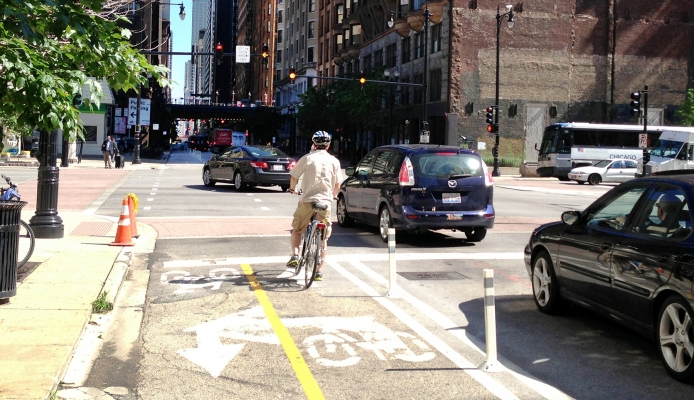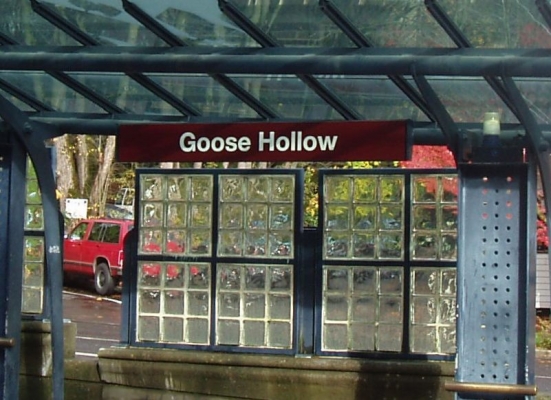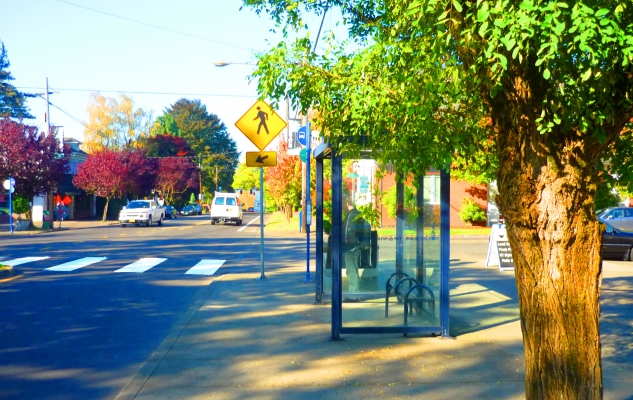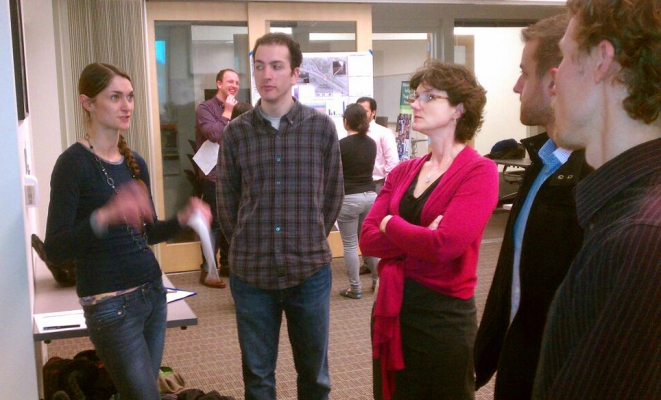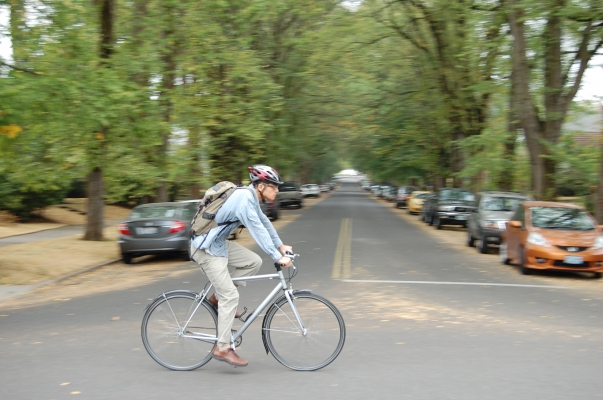Protected bicycle lanes have gained popularity as a safer way to get more people cycling. Earlier research from the Transportation Research and Education Center, TREC, at Portland State University showed that people feel safer in lanes with a physical barrier between bicycle and motor vehicle traffic.
The research hadn’t closely studied the intersections, where the barriers—and the protection they offer—go away. With little research guidance, agencies across the country could face the prospect of using untested approaches or avoiding protected lanes altogether.
TREC, through its National Institute for Transportation and Communities pooled-fund program, is now addressing intersections for protected lanes. The program lets agencies and interested partners invest small amounts to join research with a national impact. For this project, 11 partners each put $5,000 to $50,000 toward the $250,000 cost.
The project will help agencies decide which intersection treatments to use in which cases, and what elements each should include. Toole Design Group will work with the Portland State research team to tailor the results to practitioners.
“Right now, it’s based on their judgment,” said...
A group led by Krista Hager worked on a concept design for bicycle parking at the Goose Hollow eastbound MAX Station in southwest Portland, Ore.
The U.S. Department of Housing and Urban Development has identified some “livability principles” which include healthy, safe and walkable neighborhoods and safe, reliable and economical transportation choices.
Transit agencies and local governments routinely use metrics to evaluate the performance of transit systems, but a uniform standard of transit data collection does not exist outside of the reporting requirements of the National Transit Database (NTD). Because of the types of data collected for the NTD, the focus of performance measurements is often on ridership and financial performance, leaving aside the question of livability.
In a new project sponsored by OTREC, Principal Investigator Marc Schlossberg, associate professor in the department of planning, public policy and management at the University of Oregon, along with co-investigators Jennifer Dill of Portland State University and Nico Larco, also of the University of Oregon, set out to create a set of tested and refined performance indicators that transit agencies across the nation can use to evaluate and improve their system performance in relation to livability goals.
Traditionally, transit systems are thought of exclusively in their wholeness: how the system serves a region,...
Read moreAn OTREC project recently took an in-depth look at the travel-time and health-related effects of a new implementation of a state of the art adaptive traffic system.
Southeast Powell Boulevard is a multimodal urban corridor connecting highway US-26 through Portland, Oregon. The corridor is highly congested during morning and evening peak traffic hours. In October 2011, an adaptive traffic system called SCATS was deployed.
The primary function of SCATS, or Sydney Coordinated Adaptive Traffic System, is to mitigate traffic congestion. Using sensors (usually inductive loops) at each traffic signal, the system tries to find the best cycle time and phasing along the corridor as traffic demand patterns change.
In this integrated multimodal study, OTREC researchers looked at the corridor’s traffic speed and transit reliability, before and after the implementation of SCATS. In addition, a novel contribution of this study was to study the link between signal timing and air quality.
To determine the impact of SCATS on traffic and transit performance, researchers established and measured performance measures before and after SCATS. The researchers used data provided by TriMet, Portland's transit authority, to compare transit times before and after SCATS as well as traffic volume data from two Wavetronix units that were installed by the City of Portland; these units collect traffic counts, speeds and classifications. For the air quality study, TriMet also...
Read moreThe Beaverton-Hillsdale Highway, pegged as one of Portland’s high-crash corridors, already attracted the attention of city officials worried about safety. They got more help from Portland State University students during the recently completed term.
Students from civil engineering professor Christopher Monsere’s transportation safety analysis course formed six groups, each studying a piece of the corridor. They presented their findings and recommendations during the course’s open house March 19. The presentation drew officials from local agencies interested in improving corridor safety, including the city of Portland, the TriMet transit agency and the Metro regional government.
The student work dovetails with the city’s own examination of the highway corridor, completed in February. In some cases, as with the Shattuck Road intersection, the students came to many of the same conclusions as city officials, said Wendy Cawley, traffic safety engineer with the Portland Bureau of Transportation. Both found that narrowing the crossing distance could make that intersection safer for pedestrians.
One group looked at the Hillsdale area, recommending a “road diet” approach and other livability-minded changes. While it’s “probably a little more than the city will be able to recommend and handle,” Cawley said, the work has inspired...
Read moreWhen policymakers look to meet cycling goals by investing in new bicycle routes, they have little research to help them determine whether cyclists will actually use them. As a result, bicycle facilities aren’t considered equally with motor vehicle infrastructure.
That’s changing, thanks in part to OTREC research. An OTREC-funded study, the first to gather large-scale data that reveal cyclists’ actual route preference, is being published in a scientific journal (Transportation Research Part A). The findings have already been incorporated into the regional travel demand model used to make transportation investment decisions across the Portland region.
In the study, Portland State University researchers Joseph Broach, Jennifer Dill and John Gliebe (Gliebe is now with RSG Inc.) outfitted cyclists with GPS units to record which routes they chose and model the choices to reveal preferences. Previous studies have relied on stated preference surveys or less reliable methods of determining cyclists’ actual routes. The data gathering was supported by a grant from the Robert Wood Johnson Foundation through its national...
Read moreFor transit planning expert Jarrett Walker, one of the fundamentals of transit is also one of the hardest points for people to figure out: you can’t make good transit-system decisions from behind the wheel of a car.
“If you’re a habitual motorist, it doesn’t matter how much you support transit, there are certain things about it you’re not likely to get,” Walker said. “One the most basic, if you’re a motorist or a cyclist for that matter, you’re going to appreciate the concept of speed but not the concept of frequency.
“In urban transit, frequency is vastly more important than speed in determining how soon you get where you're going.”
Walker, the author of “Human Transit: How Clearer Thinking About Public Transit Can Enrich Our Communities And Our Lives,” presents his work at three OTREC-sponsored forums in Eugene and Portland May 16-18. Click here for more information on the presentations and Walker.
While driving or cycling faster typically means arriving earlier, slow transit vehicles that run often will get you to your destination sooner than fast, infrequent ones, Walker said. “It’s very difficult to get motorists to understand that importance. I tell them to imagine a gate at the end of your...
Read moreThe video begins at 2:58.
Abstract: While TriMet and other transit agencies serve many commuters by having racks for bikes on trains and buses, large bike parking facilities in global capitals of urban bicycling provide the key link between bikes and transit. Following the lead of European and Asian cities, the Portland region is starting to develop a network of bike-transit facilities; TriMet is piloting smart bike parking technology in the form of electronic bike lockers and "Bike & Rides". This presentation discusses the background and planning for bike-transit integration in the region and shares insights into bike-transit travel patterns, habits, and market segmentation gained from recent rider surveys.

